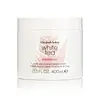What's inside
What's inside
 Key Ingredients
Key Ingredients

 Benefits
Benefits

 Concerns
Concerns

 Ingredients Side-by-side
Ingredients Side-by-side

Water
Skin ConditioningParaffinum Liquidum
EmollientCetearyl Alcohol
EmollientParfum
MaskingGlycerin
HumectantCaprylic/Capric Triglyceride
MaskingGlyceryl Stearate
EmollientCetyl Acetate
EmollientCeteareth-20
CleansingTheobroma Cacao Seed Butter
EmollientDimethicone
EmollientC12-15 Alkyl Benzoate
AntimicrobialAcetylated Lanolin Alcohol
EmollientAchillea Millefolium Extract
CleansingAesculus Hippocastanum Seed Extract
Skin ConditioningAlthaea Officinalis Root Extract
Skin ConditioningButylene Glycol
HumectantButyrospermum Parkii Butter
Skin ConditioningCamellia Sinensis Leaf Extract
AntimicrobialCaprylyl Glycol
EmollientCarbomer
Emulsion StabilisingChamomilla Recutita Flower Extract
MaskingChondrus Crispus Extract
Skin ConditioningEquisetum Arvense Extract
AstringentFoeniculum Vulgare Seed Extract
Skin ConditioningHamamelis Virginiana Leaf Extract
Skin ConditioningHedera Helix Extract
AntimicrobialHumulus Lupulus Extract
AntimicrobialLavandula Angustifolia Flower Extract
CleansingPropylene Glycol
HumectantRosmarinus Officinalis Leaf Extract
AntimicrobialSalvia Officinalis Leaf Extract
CleansingSambucus Nigra Flower Extract
RefreshingTaraxacum Officinale Leaf Extract
Skin ConditioningTetrasodium EDTA
Thymus Vulgaris Leaf Extract
Skin ProtectingTriceteareth-4 Phosphate
EmulsifyingTromethamine
BufferingTussilago Farfara Leaf Extract
AstringentCitral
PerfumingCitronellol
PerfumingCoumarin
PerfumingFarnesol
PerfumingGeraniol
PerfumingHexyl Cinnamal
PerfumingHydroxycitronellal
PerfumingLimonene
PerfumingLinalool
PerfumingPhenoxyethanol
PreservativeSodium Benzoate
MaskingWater, Paraffinum Liquidum, Cetearyl Alcohol, Parfum, Glycerin, Caprylic/Capric Triglyceride, Glyceryl Stearate, Cetyl Acetate, Ceteareth-20, Theobroma Cacao Seed Butter, Dimethicone, C12-15 Alkyl Benzoate, Acetylated Lanolin Alcohol, Achillea Millefolium Extract, Aesculus Hippocastanum Seed Extract, Althaea Officinalis Root Extract, Butylene Glycol, Butyrospermum Parkii Butter, Camellia Sinensis Leaf Extract, Caprylyl Glycol, Carbomer, Chamomilla Recutita Flower Extract, Chondrus Crispus Extract, Equisetum Arvense Extract, Foeniculum Vulgare Seed Extract, Hamamelis Virginiana Leaf Extract, Hedera Helix Extract, Humulus Lupulus Extract, Lavandula Angustifolia Flower Extract, Propylene Glycol, Rosmarinus Officinalis Leaf Extract, Salvia Officinalis Leaf Extract, Sambucus Nigra Flower Extract, Taraxacum Officinale Leaf Extract, Tetrasodium EDTA, Thymus Vulgaris Leaf Extract, Triceteareth-4 Phosphate, Tromethamine, Tussilago Farfara Leaf Extract, Citral, Citronellol, Coumarin, Farnesol, Geraniol, Hexyl Cinnamal, Hydroxycitronellal, Limonene, Linalool, Phenoxyethanol, Sodium Benzoate
Water
Skin ConditioningGlycerin
HumectantPetrolatum
EmollientDicaprylyl Ether
EmollientDimethicone
EmollientGlyceryl Stearate
EmollientCetyl Alcohol
EmollientHelianthus Annuus Seed Oil
EmollientPEG-30 Stearate
EmulsifyingPanthenol
Skin ConditioningNiacinamide
SmoothingPrunus Amygdalus Dulcis Oil
Skin ConditioningTocopheryl Acetate
AntioxidantPantolactone
HumectantDimethiconol
EmollientAcrylates/C10-30 Alkyl Acrylate Crosspolymer
Emulsion StabilisingCarbomer
Emulsion StabilisingPropylene Glycol
HumectantDisodium EDTA
Benzyl Alcohol
PerfumingPhenoxyethanol
PreservativeSodium Hydroxide
BufferingCitric Acid
BufferingWater, Glycerin, Petrolatum, Dicaprylyl Ether, Dimethicone, Glyceryl Stearate, Cetyl Alcohol, Helianthus Annuus Seed Oil, PEG-30 Stearate, Panthenol, Niacinamide, Prunus Amygdalus Dulcis Oil, Tocopheryl Acetate, Pantolactone, Dimethiconol, Acrylates/C10-30 Alkyl Acrylate Crosspolymer, Carbomer, Propylene Glycol, Disodium EDTA, Benzyl Alcohol, Phenoxyethanol, Sodium Hydroxide, Citric Acid
 Reviews
Reviews

Ingredients Explained
These ingredients are found in both products.
Ingredients higher up in an ingredient list are typically present in a larger amount.
Carbomer is a polymer of acrylic acid. Its main role is to create a gel consistency.
A high amount of carbomer can cause pilling or balling up of products. Don't worry, most products contain 1% or less of carbomer.
Dimethicone is a type of synthetic silicone created from natural materials such as quartz.
What it does:
Dimethicone comes in different viscosities:
Depending on the viscosity, dimethicone has different properties.
Ingredients lists don't always show which type is used, so we recommend reaching out to the brand if you have questions about the viscosity.
This ingredient is unlikely to cause irritation because it does not get absorbed into skin. However, people with silicone allergies should be careful about using this ingredient.
Note: Dimethicone may contribute to pilling. This is because it is not oil or water soluble, so pilling may occur when layered with products. When mixed with heavy oils in a formula, the outcome is also quite greasy.
Learn more about DimethiconeGlycerin is already naturally found in your skin. It helps moisturize and protect your skin.
A study from 2016 found glycerin to be more effective as a humectant than AHAs and hyaluronic acid.
As a humectant, it helps the skin stay hydrated by pulling moisture to your skin. The low molecular weight of glycerin allows it to pull moisture into the deeper layers of your skin.
Hydrated skin improves your skin barrier; Your skin barrier helps protect against irritants and bacteria.
Glycerin has also been found to have antimicrobial and antiviral properties. Due to these properties, glycerin is often used in wound and burn treatments.
In cosmetics, glycerin is usually derived from plants such as soybean or palm. However, it can also be sourced from animals, such as tallow or animal fat.
This ingredient is organic, colorless, odorless, and non-toxic.
Glycerin is the name for this ingredient in American English. British English uses Glycerol/Glycerine.
Learn more about GlycerinGlyceryl Stearate is a mix of glycerin and stearic acid.
It is used to stabilize the mixing of water and oil ingredients. By preventing these ingredients from separating, it can help elongate shelf life. It can also help thicken the product's texture.
As an emollient, it helps soften skin and supports barrier-replenishing ingredients.
In cosmetics, Glyceryl Stearate is often made from vegetable oils or synthetically produced.
This ingredient may not be fungal-acne safe
Fun fact: The human body also creates Glyceryl Stearate naturally.
Learn more about Glyceryl StearatePhenoxyethanol is a preservative that has germicide, antimicrobial, and aromatic properties. Studies show that phenoxyethanol can prevent microbial growth. By itself, it has a scent that is similar to that of a rose.
It's often used in formulations along with Caprylyl Glycol to preserve the shelf life of products.
Propylene Glycol is an odorless, colorless liquid. As a humectant, it helps skin retain moisture. It also aids in delivering active ingredients.
Another role of this ingredient is preventing a product from melting or freezing. Propylene glycol also adds antimicrobrial properties to a product, elongating product lifespan.
This ingredient is considered an organic alcohol and commonly added into both cosmetics and foods.
Those with sensitive skin or conditions may develop a rash when using this ingredient.
Learn more about Propylene GlycolWater. It's the most common cosmetic ingredient of all. You'll usually see it at the top of ingredient lists, meaning that it makes up the largest part of the product.
So why is it so popular? Water most often acts as a solvent - this means that it helps dissolve other ingredients into the formulation.
You'll also recognize water as that liquid we all need to stay alive. If you see this, drink a glass of water. Stay hydrated!
Learn more about Water